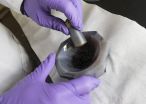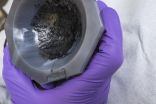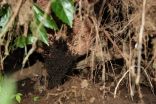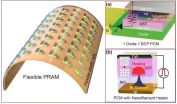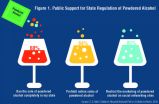(Press-News.org) A simple way to turn carbon nanotubes into valuable graphene nanoribbons may be to grind them, according to research led by Rice University.
The trick, said Rice materials scientist Pulickel Ajayan, is to mix two types of chemically modified nanotubes. When they come into contact during grinding, they react and unzip, a process that until now has depended largely on reactions in harsh chemical solutions.
The research by Ajayan and his international collaborators appears in Nature Communications.
To be clear, Ajayan said, the new process is still a chemical reaction that depends on molecules purposely attached to the nanotubes, a process called functionalization. The most interesting part to the researchers is that a process as simple as grinding could deliver strong chemical coupling between solid nanostructures and produce novel forms of nanostructured products with specific properties.
"Chemical reactions can easily be done in solutions, but this work is entirely solid state," he said. "Our question is this: If we can use nanotubes as templates, functionalize them and get reactions under the right conditions, what kinds of things can we make with a large number of possible nanostructures and chemical functional groups?"
The process should enable many new chemical reactions and products, said Mohamad Kabbani, a graduate student at Rice and lead author of the paper. "Using different functionalities in different nanoscale systems could revolutionize nanomaterials development," he said.
Highly conductive graphene nanoribbons, thousands of times smaller than a human hair, are finding their way into the marketplace in composite materials. The nanoribbons boost the materials' electronic properties and/or strength.
"Controlling such structures by mechano-chemical transformation will be the key to find new applications," said co-author Thalappil Pradeep, a professor of chemistry at the Indian Institute of Technology Chennai. "Soft chemistry of this kind can happen in many conditions, contributing to better understanding of materials processing."
In their tests, the researchers prepared two batches of multi-walled carbon nanotubes, one with carboxyl groups and the other with hydroxyl groups attached. When ground together for up to 20 minutes with a mortar and pestle, the chemical additives reacted with each other, triggering the nanotubes to unzip into nanoribbons, with water as a byproduct.
"That serendipitous observation will lead to further systematic studies of nanotubes reactions in solid state, including ab-initio theoretical models and simulations," Ajayan said. "This is exciting."
The experiments were duplicated by participating labs at Rice, at the Indian Institute of Technology and at the Lebanese American University in Beirut. They were performed in standard lab conditions as well as in a vacuum, outside in the open air and at variable humidity, temperatures, times and seasons.
The researchers who carried out the collaboration on three continents still don't know precisely what's happening at the nanoscale. "It is an exothermic reaction, so the energy's enough to break up the nanotubes into ribbons, but the details of the dynamics are difficult to monitor," Kabbani said. "There's no way we can grind two nanotubes in a microscope and watch it happen. Not yet, anyway."
But the results speak for themselves.
"I don't know why people haven't explored this idea, that you can control reactions by supporting the reactants on nanostructures," Ajayan said. "What we've done is very crude, but it's a beginning and a lot of work can follow along these lines."
INFORMATION:
Co-authors are Rice graduate students Chandra Sekhar Tiwary, Sehmus Ozden and Yongji Gong; Pedro Autreto, Gustavo Brunetto and Professor Douglas Galvao of the State University of Campinas, Brazil; Anirban Som and K.R. Krishnadas of the Indian Institute of Technology Madras; Robert Vajtai, a senior faculty fellow at Rice, and Ahmad Kabbani, an adjunct faculty member at Rice and a professor of chemistry at the Lebanese American University, Beirut. Ajayan is chair of Rice's Department of Materials Science and NanoEngineering, the Benjamin M. and Mary Greenwood Anderson Professor in Engineering and a professor of chemistry.
Watch a video about the research at http://youtu.be/kcXyF0H6ONU
Read the paper at http://www.nature.com/ncomms/2015/150615/ncomms8291/full/ncomms8291.html
This news release can be found online at http://news.rice.edu/2015/06/15/researchers-grind-nanotubes-to-get-nanoribbons/
Follow Rice News and Media Relations via Twitter @RiceUNews
Related Materials:
Ajayan Research Group: http://ajayan.rice.edu
Rice Department of Materials Science and NanoEngineering: https://msne.rice.edu
The city where an individual lives can influence the risk of dying by suicide, according to a new study from sociologists at Rice University and the University of Colorado at Boulder.
"Suicide in the City: Do Characteristics of Place Really Influence Risk?" appears in the latest edition of Social Science Quarterly. The study found that adults living in cities with more socio-economic disadvantages and fewer families living together have higher odds of suicidal death than adults living in less-disadvantaged cities and cities with more families living together.
The findings ...
PHILADELPHIA (June 15, 2015) - Army ants, the nomadic swarming predators underfoot in the jungle, can take down a colony of prey animals without breaking a sweat. But certain army ant species can't take the heat.
According to a new study from Drexel University, underground species of army ants are much less tolerant of high temperatures than their aboveground relatives--and that difference in thermal tolerance could mean that many climate change models lack a key element of how animal physiology could affect responses to changing environments.
At face value, this is ...
Scientists at the University of Southampton have found a way to pry into the private lives of fish - by looking in their ears.
By studying ear stones in fish, which act as tiny data recorders, scientists can now reveal migration patterns and even provide insights into their sex life.
Managing fish stocks in a sustainable way is a major challenge facing scientists, conservationists, policy makers and fishermen. To get the best results, accurate information about the movements of fish in the wild is needed but gathering this information is extremely difficult.
Tiny ...
Daejeon, Republic of Korea, Jun 15, 2015 -- Phase change random access memory (PRAM) is one of the strongest candidates for next-generation nonvolatile memory for flexible and wearable electronics. In order to be used as a core memory for flexible devices, the most important issue is reducing high operating current. The effective solution is to decrease cell size in sub-micron region as in commercialized conventional PRAM. However, the scaling to nano-dimension on flexible substrates is extremely difficult due to soft nature and photolithographic limits on plastics, thus ...
From the adventures of Lara Croft in Tomb Raider to the apocalyptic drama of Fallout - new research from the University of Warwick has revealed the secret to how some of the world's most iconic video games were created.
Professor David Stark says it is because the creative teams behind these ground-breaking titles had the ideal mix of career backgrounds and working relationships.
He claims his research offers a fresh insight into the factors which
stimulate innovation - theories that can also apply away from the video gaming industry.
The 'Big Data' analysis looked ...
Humans are unlikely to be the only animal capable of self-awareness, a new study has shown.
Conducted by University of Warwick researchers, the study found that humans and other animals capable of mentally simulating environments require at least a primitive sense of self. The finding suggests that any animal that can simulate environments must have a form of self-awareness.
Often viewed as one of man's defining characteristics, the study strongly suggests that self-awareness is not unique to mankind and is instead likely to be common among animals.
The researchers, ...
Scientists from the Icahn School of Medicine at Mount Sinai have developed a new technique to more precisely analyze bacterial populations, to reveal epigenetic mechanisms that can drive virulence. The new methods hold the promise of a potent new tool to offset the growing challenge of antibiotic resistance by bacterial pathogens. The research was published today in the journal Nature Communications, and conducted in collaboration with New York University Langone Medical Center and Brigham and Women's Hospital of Harvard Medical School.
The information content of the ...
Scientists at Helmholtz Zentrum München have now discovered how Epstein-Barr virus (EBV) conceals itself in human cells. A main culprit for its bad visibility by the immune system is the viral protein LMP2A. As published in the scientific journal PLOS Pathogens, the protein helps EBV-infected cells hide from T cells. This camouflage through the LMP2A protein may play a major role in the causation of cancer by EBV.
„We suspected that a viral protein was behind EBV's camouflage in cancerous cells", says Dr. Andreas Moosmann from the Research Unit Gene Vectors ...
ANN ARBOR, Mich. -- After this year's legalization of powdered alcohol, some states have already banned it -- a move that the majority of the public supports, according to a new University of Michigan C.S. Mott Children's Hospital National Poll on Children's Health.
Adults across the country share the same top concern about the new alcohol-on-the-go product: potential misuse among underage youth.
Packaged in travel-friendly pouches, powdered alcohol will be available in flavors of distilled spirits like vodka and rum and also mixed drinks. One packet of powdered alcohol ...
Lisbon, 15 June 2015: In October last year the Gothenburg, Sweden, group of Mats Bra?nnstro?m announced the world's first live birth following the transplantation of a donated uterus.(1) In an editorial accompanying the report, The Lancet listed this remarkable achievement as comparable to only three other landmarks in the history of reproductive medicine: "the arrival of in-vitro fertilisation (IVF) in the late 1970s; the development of intracytoplasmic sperm injection (ICSI) in the early 1990s; the first ovarian transplant a decade ago; and [now] the first live birth ...
